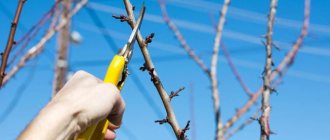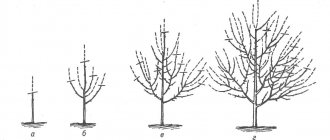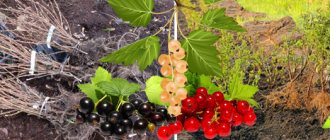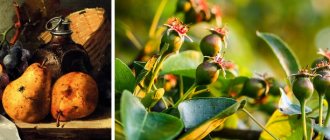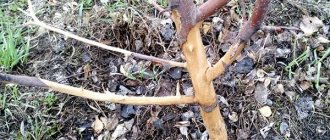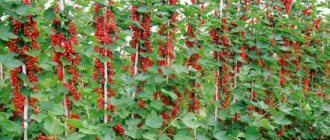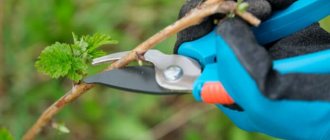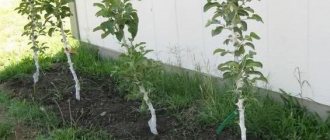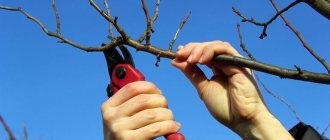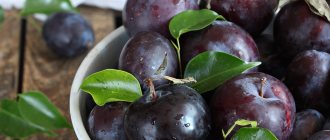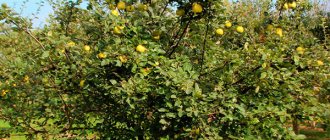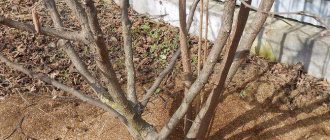Gardening » Pear
1
2316
Article rating
Kira Stoletova
Pruning a columnar pear is slightly different from the procedure that is used for other pear varieties. This is due to the characteristics of columnar varieties.
Pruning Columnar Pear
Features of columnar pears
The most important feature of the columnar pear is its compactness. The branches do not spread out to the sides, but are pressed tightly against the trunk; the fruits are formed directly near the base.
The yield of columnar trees is several times higher than that of classic pears, and there is much less maintenance.
Many people mistakenly assume that a tree has no branches, but this is not true. In the process of genetic changes, they have become smaller and are adjacent to the trunk. The fruits are attached by their stalks to the base of the knots, thereby creating the effect of clinging to the tree.
When do they begin to bear fruit?
Columnar pears, like columnar apple trees, begin to bear fruit in the second year. Their yield is abundant and has not decreased for several years. Each growing season, plants can produce from 2.5 to 3.5 kg per unit. For a compact tree these are very good indicators.
Fruiting continues for 10-15 years, then it declines and stops completely. By this period, it is worth taking care of planting new specimens, and leaving the old ones as a decorative decoration for the garden.
It is best to harvest the first harvest slightly unripe to allow the tree to regain its strength.
How do they reproduce?
Since the columnar pear is a selective crop, it is very difficult to propagate by seeds.
Farmers prefer to buy new seedlings bred in two popular ways:
- vaccination;
- cuttings.
Seeds
It is possible to propagate the columnar pear from seeds, but breeders do not recommend it.
The process is complex, painstaking and takes a lot of time. Sometimes it takes more than 2 years to grow a seedling, and it is also possible to breed several specific varieties in this way. On the other hand, the resulting trees have natural, non-mutated parental genes.
Vaccinations
The most common scion for dwarf pear is quince, serviceberry. It is carried out in mid-spring, when the growing season has already started, and frosts and sudden temperature changes have passed. This is necessary for better adaptation of the vaccine, therefore in the middle zone they are vaccinated only at the end of April - the second half of May. There are conditions that must be observed when grafting:
- The time of day is either early morning or late evening. If the weather is cloudy, then you can do it during the day.
- Harvesting cuttings begins in winter and is stored in a dry, cool place.
- The instruments are prepared clean and, if necessary, further sharpened. The sharper the knife, the more precise the movement, and the less damage to the tree.
- The length of the scion should not exceed 80 cm, but should not be significantly lower than 70 cm.
- The grafting site is bandaged with electrical tape and sealed with garden broth.
Vaccinations are done in three ways:
- lifting the bark;
- making a side cut;
- into cleft
The survival period of the cuttings is up to 1 month.
Cuttings
Cuttings are prepared in advance, choosing one- or two-year-olds with 2-3 internodes and a height of no more than 30 cm. Then the cuttings are placed in a root solution for 48 hours. For better formation of the root system, the bottom is cleaned.
When the first tubercles appear on the trunk, the cuttings are dug into the ground and covered with polyethylene. Many gardeners mix the soil with peat or sphagnum to provide the maximum amount of nutrients.
In this way, trees take root quickly, within 2-3 weeks.
Why do you need pear pruning?
Garden trees need proper care. Only in this case it is possible to get a good harvest. Columnar pears were developed relatively recently. They differ from ordinary pears in their small size (the tree grows no more than 2.5 m in height) and sparse crown. The side branches of such trees are short.
Some gardeners have come to love dwarf pears for their decorativeness and unusual appearance. Fruit crops are planted along the edges of the plot and in limited areas. The crown is not dense, so you can plant vegetables and flowers under the tree.
Columnar pears can also be planted next to beds. The branches will not shade the plantings. But for the proper development of the crop, the crown needs to be formed. Beginning gardeners need to pay attention to pruning. This must be done annually. This procedure allows you to solve several problems at once:
- improve light access to the side trunk;
- form branches correctly;
- protect the tree from diseases;
- increase productivity.
Columnar pears have very few or no fruiting branches. The trees are considered dwarf. They also have disadvantages, the main ones being a short fruiting period and low yield. From one tree it is possible to collect only 4-6 kg of aromatic fruits per season. With proper care, pears stop bearing fruit 12-14 years after planting. If you do not prune, this period is reduced to 7-9 years. In this case, the crown is formed incorrectly, the trees do not look very beautiful.
Varieties
Like ordinary, classic trees, columnar pears come in different varieties:
- ripening in early autumn;
- summer-autumn options;
- autumn;
- autumn-winter;
- winter.
Of course, each type differs not only in the weight of the fruit, but also in taste. For example, pears that ripen in early autumn have a rich aroma, bright yellow color and juicy flesh. The weight of the fruit can reach up to 400 grams.
Late-ripening, autumn pears have an orange side, skin, as if covered with oil, and the weight is 2 times less than early-ripening ones.
Very winter varieties reach 150-200 grams, the pulp is dense, but aromatic with a slight honey tint. They are also characterized by small spots on the skin.
Pears that ripen early are looser and are not capable of storing for a long time; winter varieties are elastic, dry and are sometimes stored until spring.
Gardeners identify several of the most popular varieties.
Decor
The Decorah pear is small and classified as semi-dwarf, its maximum height is 2.2 meters. In addition, the variety has the following species characteristics:
- It is unpretentious to the composition of the soil, resistant to infections and viruses, and also frost-resistant.
- The pear begins to bear fruit 2 years after planting in its main place.
- The fruits of the columnar pear have a sweet-sour taste and are very juicy. They are compared to the scent of a rose.
- The shape of the fruit is oval, its weight ranges from 200-230 grams. At the same time, the skin is quite thin, so the fruits are not a shelf-stable variety.
- The color is intense yellow.
It is important to note that this is a late-ripening variety, so it is not recommended to plant the tree in northern latitudes. There are other pear varieties for Siberia that are recommended for cultivation.
Sapphira
Sapphira is a variety that ripens in mid-autumn. Pear picking begins in the first half of September and ends in early October, before the first frost.
- Fruiting of the Sapphira variety begins in the 3rd year after transplantation;
- fruit weight up to 200-250 grams;
- shape , widening towards the bottom;
- color is yellow with a green tint and small dark brown spots;
- frost resistance is relatively good;
- The tree is also immune to scab.
Gardeners determine the readiness of fruits for harvesting by the appearance of a red blush on the pear.
Delight
The Delight variety is a relatively new variety of columnar pear, ideal for the middle zone, the Moscow region. Breeders bred it with relative resistance to frost, but at the same time with a rapid ripening stage.
Already at the end of July, the first fruits are collected from the tree. Their taste is bright, juicy with a slight honey tint and slight sourness. The weight of the fruit is about 150 grams and is elongated.
Carmen
Carmen, like Delight, is a summer variety. A characteristic feature of the variety is the burgundy color of the fruits, weighing up to 300 grams. Thanks to these qualities, the pear is incredibly popular among gardeners; entire orchards of 1.4-2000 specimens are formed from the trees.
In terms of taste, pears are classified as dessert fruits; the fruit is juicy, sickly sweet with a thin skin. The first harvest ripens in early June, and the first fruiting after planting is possible in the second year.
Carmen is also used for landscape design, since the pear has a bright and textured appearance, both during the fruiting and flowering seasons.
Types of pruning
Experienced gardeners distinguish several types of pruning: sanitary, rejuvenating and shaping. Sanitation involves removing diseased twigs, dry branches and shoots that grow crookedly. It's quite simple to do. Branches with damaged bark and dry shoots are visible to the naked eye.
Formative pruning is more complex. In this case, gardeners not only remove all old and non-viable branches, but also form a crown. Formative pruning must be done in the first 5 years after planting the pear in a permanent place. Subsequently, it can not be performed every year. When doing this pruning, you need to be guided by the following basic principles:
- remove all young shoots and branches growing below the first tier;
- All diseased and dried branches must be pruned;
- remove all tops (growth growing vertically);
- All branches growing inside the crown, crossing branches and branches looking down must be removed.
Young growth near the trunk must be cut out, as well as branches that are too sharp (growing at an angle of less than 45 degrees relative to the trunk). Dwarf pears are not as difficult to form as regular ones. In the first year after planting, it is recommended to shorten all branches growing from the trunk, leaving stumps about 3 cm long. This is necessary in order to increase nutrition of the trunk and strengthen it.
Advantages and disadvantages of trees
Columnar pears are grown in farm gardens for many reasons:
- The trees take up little space, but bear fruit already in 2-3 years and very intensively.
- In addition to good yield, pears provide an aesthetic appearance.
- Due to their compactness, without spreading branches, gardeners plant them more densely, which further increases the yield.
- Plants take root quickly and almost painlessly.
- The fruits of early varieties are large and reach 300 grams, while the low growth of trees up to 2.5 meters helps to quickly harvest the fruit.
- The pear is unpretentious to the soil and is frost-resistant.
- The fruits are used both raw and for various preservations, jams and compotes.
There are only two disadvantages of the columnar type pear:
- The maximum fruiting period is no more than 15 years, and in some types up to 10 years.
- The range of varieties is not very large.
Requirements for watering and fertilizers
Caring for a columnar pear begins with developing a watering regime. On cold days, you can moisten the soil once every 5–6 days; in winter, the frequency should be reduced to 1 time in 12 days. In spring and summer, the frequency is increased to 8 times a month, and in hot weather the tree is watered every 2 days. The volume of water depends on the age of the tree, but it should be at least 5 liters and no more than 15 liters.
To ensure that the soil retains moisture longer, it is mulched on top with a mixture of wood ash, humus and straw. In addition, to ensure that sufficient oxygen reaches the roots, the soil is loosened weekly. Mulching is also useful in winter - this procedure helps protect the roots from freezing.
There are two watering technologies that a gardener can choose at his discretion.
The first technology involves watering into the hole around the stem. Thanks to this method, moisture comes directly to the root system.
The second method is considered more effective, although it requires large volumes of water. There is such a thing as “nutrition area” - it is outlined in the form of a circle, and it means the area of growth of the root system. For younger trees, the radius is 70–80 cm; for older trees, it can reach 130 cm. Applying water over the entire feeding area means uniformly feeding the roots of the tree.
Caring for a columnar pear also includes feeding. They can be applied in both solid and liquid form. For a dwarf pear, 5 feedings are recommended throughout the year:
- The first fertilizing is applied in early spring and should consist of humus and nitrogenous fertilizers, which promote the development of greenery.
- After green leaves appear, a solution of 10 g of urea and 2 liters of water is added.
- The third feeding is made from the same composition, but is applied 2 weeks after the last one.
- The composition of urea and water is applied for the fourth time 4 weeks after the last feeding.
- For the fifth time in mid-late summer, fertilizers from phosphates and potassium are applied, which promote the formation of fruits.
Features of cultivation
The root system of columnar pears develops in a horizontal plane and is located near the surface.
Due to the peculiarity of their structure, trees are planted in the spring, thereby minimizing the risk of extinction and the adaptation period. The soil for seedlings is prepared 2-3 weeks before the expected date:
- a hole is dug about half a meter deep and about 60 cm in diameter;
- the distance between rows is 1 meter.
Preparing the soil and pit
The soil for the planting hole consists of:
- humus;
- compost;
- natural earth;
- organic fertilizers.
On average, 3-4 kg of soil and 1 bucket of settled water are calculated per tree.
Distance between trees
Despite the fact that columnar pears do not have lateral shoots and are compact in size, gardeners recommend maintaining certain distances between trees. Row spacing should be at least 1-1.25 m;
the distance in the row is from 40 to 50 cm. Smaller sizes can lead to a lack of air and light, which will directly affect the amount of harvest, as well as the spread of diseases.
In close proximity, scab can be transmitted from one tree to another with lightning speed.
Features of the root system
As noted above, the root system of the columnar pear is poorly developed; the shoots spread horizontally without going deep into the ground. On the one hand, this is a plus for adaptation, since the top layer has more nutrients and is warmer.
On the other hand, the shallow root system does not tolerate frost well and adapts less well when planting in the autumn.
Selection of seedlings
To have a healthy garden with a bountiful harvest, gardeners adhere to several rules when choosing planting material:
- Trees are taken as one- or two-year-olds.
- The seedling must have all the necessary documents, as well as recommendations for care.
- A healthy pear has green, juicy bark and leaves.
Older seedlings can be carriers of various infectious diseases.
Landing rules
After the soil has been prepared and a hole has been dug, planting begins. The pit is moistened generously with water and allowed to soak. Then the seedling is placed vertically, with the root system straightened.
To ensure that the root system expands as much as possible and does not bunch up during the digging process, pegs are driven between them.
They try to leave the grafting site above the surface of the earth, and cover the entire root system.
The soil is filled in two stages:
- filling half the pit;
- neat compaction;
- remaining land.
After completing the procedure, the seedling is watered again and soil is added to the failed areas.
Features of the work and timing of its implementation
It is necessary to immediately decide when to carry out the work. If you make a mistake with these points, you can cause great harm to the tree; it will take a whole season or even longer to recover from the damage, because of this the yield will drop several times.
Spring
During this period, the crown is often formed. The season is only suitable at a time when the plant has not yet awakened and active sap flow has not begun. After the buds swell and the leaves open, you cannot prune the pear. This option has the following features:
- Sanitary pruning must be carried out. The entire crown is carefully inspected, damaged, broken and frostbitten shoots are removed. It is easy to distinguish them during this period, when there are no leaves yet.
- If no work was carried out in the fall, then it can be formed in the spring. Thin out the crown, remove excess branches, reduce the load.
- During this period, it is important to monitor the weather. If there is frost after pruning, there is a high probability of damage to the shoots. Therefore, choose a moment with stable heat and no sub-zero temperatures.
- Plants experience stress and move away for some time after waking up. The cuttings do not have time to fully heal by the beginning of the growing season, which is not very good.
It is not difficult to select the time for work, but it differs for different regions. Understand all the recommendations and follow them to find the right moment:
- In the Moscow region, the middle zone, a favorable moment begins around mid-April. After the onset of stable warm weather, begin work to cope before the buds begin to open.
- In the south, pruning can be done from March. Based on the weather conditions for the season, as well as the forecast for the near future. In these regions, everything is simpler, since the danger of frost is low, even if you start very early, nothing bad will happen.
- In Siberia, the Urals and other regions with cold winters and late spring, work is carried out in late April or early May. But here everything depends on the characteristics of the area, since the weather varies greatly, the dates shift by weeks.
Care
Columnar pears are unpretentious in care; only basic actions typical for an orchard are carried out on them:
- pruning;
- feeding;
- loosening;
- preparatory work for cold weather;
- protection from pests and weeds;
- watering.
Regular fulfillment of all conditions ensures a full and rich harvest of pears.
Feeding
Fertilizing is an important stage in the development of a tree, especially if it is grown on ash soil or in conditions with little daylight and a relatively short summer period.
All fertilizers are applied in the active stage of the growing season - in spring and summer. Particular attention is paid to young plantings; they are fed with slurry or chicken droppings. Plantings can also be fertilized with saltpeter and urea.
Fertilizers are never used in pure form; they are diluted with water in a ratio of 1 to 7 or 10.
The first feeding is carried out as soon as the first leaves bloom; the second – after 2 weeks, the next after another 2 weeks.
Do not forget about watering the row spacing, in particular at a distance of more than 2 meters.
Trimming
The formation of the crown and the growth of the pear itself depend on the correct pruning of the plant.
The essence of the procedure is to remove excess, while giving stronger nutrition to the remaining elements of the tree.
The trunk itself is not cut, but only the side shoots. It happens that a pear slows down its development, then it is cut off, leaving a cutting of 2-3 buds. This results in natural growth stimulation.
It should be remembered that in the first year the flowering of the tree is stopped by plucking out all the flowers.
How to trim correctly
If tree pruning is done incorrectly, this will lead to a decrease in yield and its loss. When a young columnar pear is forming, two pruning methods can be used. In the first case, the principle of operation is to shorten young shoots, that is, only the upper part of the branch is cut off. This procedure helps awaken the side shoots. In the second case, the work scheme includes thinning the branches without leaving stumps. There is spring and autumn pruning.
Spring for pear pruning
This is the best time to prune a columnar pear, but it must be done correctly and within a certain time frame. The most optimal period is March-April, because at this time the buds have not blossomed, but are just beginning to swell. Since the pear is a light-loving tree, after pruning the light should be evenly distributed to all areas of the crown. In the spring, the crown of the tree is formed in order to remove the load on thin branches after the fruits ripen. It is also very important at this time to remove all dry, weakened branches.
Autumn pruning of pear
If pruning is done in the fall, then it is done only at above-zero temperatures, and if dry leaves have not fallen, then the procedure is postponed until later.
When the time for pruning is missed, it is advisable to postpone it to early spring to prevent the branches from freezing.
Many novice gardeners, after purchasing seedlings, do not know how to prune a pear tree or whether it is necessary to prune it at all. If the tree was planted in the spring, then pruning is not done in the fall, because the branches of a young columnar pear develop very poorly. In order to properly form its crown, the first pruning is done after the first year after planting the seedling. After this, the main branch is cut at a height of 50 cm from the soil. The cut is made on the kidney and always on the opposite side of the place where the graft was.
After the second year, the trunk is cut at a height of 25 cm from the bud that is higher than last year’s shoot. In the fourth year, the tree will have 6-8 branches, but you need to leave only 3-4 of the strongest ones, cutting them at the same height. At this age, the central trunk is cut 20 cm above last year's bud. The tips of the branches and their side shoots are cut off so that next year more branches and new buds will form.
Disease Prevention
To prevent diseases from spreading to columnar pears, plants are planted around them to repel insect pests. Such herbs include: tobacco, lemon balm, mint and other strong-smelling varieties.
Also, to protect against moss and lichen, the trunk is whitened, approximately 1 meter from the ground.
Be sure to monitor the dryness of the soil, preventing it from becoming waterlogged.
At the first manifestations of rust and scab, the affected branches are cut off, the foliage is burned, and the planting itself and nearby trees are treated with a solution of urea or sulfur. In more serious cases, chemical control options are used.
Spraying
Pear trees have delicate leaves that suffer from excessive dryness, so spraying is an important and daily care procedure. The mistake of novice gardeners is that they begin to irrigate trees on hot days, although the first manipulations are carried out a few days after the snow melts.
As soon as it becomes clear that the thermometer has clearly established itself at +5°C during the day, the seedlings are sprayed, thereby hardening them and protecting them from pathogenic microbes.
Copper or iron sulfate and urea are added to the solution in the spring. For preventive purposes, the substances are diluted in a proportion of 50 g per 10 liters of water.
Protection from diseases and pests
To grow a healthy fruit tree, it should be properly cared for, protecting it from diseases and parasites.
First of all, you should take care of proper preventive care. It is extremely undesirable to over-water the tree, since excess moisture can lead to rotting of the root system. It is necessary to regularly remove fallen leaves, dry branches, and rotten fruit from around the pear. It is especially important to do this in the fall, when parasite larvae hide and overwinter in dry leaves. As a preventive measure, it is also useful to spray trees with a solution of copper sulfate.
To protect the pear tree from hypothermia, it must be prepared for winter. To do this, the surface of the soil around the trunk is mulched and covered with spruce branches, and the trunk is wrapped with roofing felt or thick fabric.
Among the most dangerous pests of dwarf pear are aphids, mites, codling moths and copperheads. Timely cleaning of the area around the tree and, in case of infection, spraying with insecticides will help prevent their occurrence. In the fight against diseases (scab and powdery mildew), insecticides and removal of infected parts of the tree will also help.
In the fight against insects and rodents, strong-smelling herbs are used, which are planted around the pear.
Characteristics of columnar pear fruits
Depending on the timing of fruit ripening, pears differ in taste, juiciness and size.
The largest varieties, up to 300 grams, ripen in the summer. They are distinguished by juicier pulp and thin skin. Such pears are amber-yellow in color, sometimes with small inclusions. The varieties are sweet, but absolutely not shelf-stable.
Winter varieties are also sweet, but the taste is sour, the flesh is denser, the skin is tight and has an oily surface. They are smaller, weighing up to 150-200 grams, but have high frost resistance and shelf life.
Preparing for winter
Preparations for winter begin at the moment when the entire harvest is harvested and all the leaves have fallen from the trunk and branches. Fallen leaves are collected along with garbage and burned.
If you don’t do this, you can create excellent soil for the proliferation of pests that usually overwinter in humus.
The weak point of columnar pears is the top. In the first 2-4 years, it is very tender and needs to be covered with fabric that protects it from frost, but at the same time allows air to pass through.
The bottom of the pear is tied with spruce branches and sprinkled with snow, thereby protecting it from rodents and hares.
Pit preparation and planting process
It is advisable to plant pears in the spring, at the end of April - beginning of May, when the possibility of frost is excluded. The seedling is pre-soaked in a solution of water and potassium sulfate for a day. The roots are then dried and examined one last time.
There is no particular difficulty in how to properly plant a dwarf pear. To ensure that the soil subsides, holes for planting are dug at least a month in advance (or even in the fall). The hole should be no more than 70 cm deep and no more than 60 cm wide. The distance between the trees can be a minimum of 50–60 cm, but it is better to leave at least a meter between the rows.
10 liters of water are poured into the hole, a layer of sand and humus is poured. The soil dug out from the hole is mixed with a small amount of humus, superphosphates and potassium fertilizers. Then the seedling is placed in the hole, the roots are carefully straightened, and the prepared soil is covered on top - so that the root collar is open by 5 cm. After this, the planted tree is watered with 15 liters of water, and the ground around is thoroughly trampled down.
After planting, a wedge up to 70 cm long is installed next to the future tree, to which the trunk is tied.
Advice from gardeners
Experienced gardeners also give advice on how to remove the maximum number of fruits from a columnar pear:
- In the first year, all flowers are removed from the pear, allowing it to gain strength for fruiting in the second year.
- In subsequent years , care is taken to ensure that the tree has enough nutrition for full development.
- The pear variety is selected relative to the growing region, so winter-hardy varieties are purchased for the middle zone.
